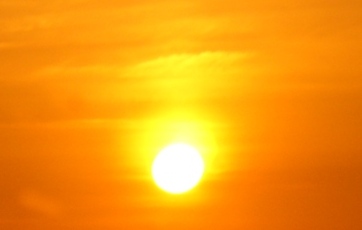Watch for These Heat Stroke Symptoms and Signs of Heat Exhaustion in Aging Parents
Heat stroke symptoms and signs of heat exhaustion could spell trouble for aging parents. In the summer, heat stroke and heat exertion can prove deadly for the elderly. Learn these signs and symptoms to keep your elders safe.
The National Weather Association issues heat warnings that need to be taken seriously. They also track heat related deaths each year.
"Heat is the number one weather-related killer. On average, more than 1,500 people in the U.S. die each year from excessive heat. This number is greater than the 30-year mean annual number of deaths due to tornadoes, hurricanes, floods and lightning combined."

Why Elderly Have High Heat Risk
The elderly are particularly vulnerable to the problems of extreme heat. Their bodies are already loosing the ability to regulate temperature very well. Some medications may also interfere with the bodies' thermostat. Senior citizens on fixed incomes may be reluctant to run air conditioners or fans as long as necessary. Seniors concerned about neighborhood safety may be hesitant to open windows for cooling breezes.
According to the Center for Disease Control, "Heat kills by pushing the human body beyond its limits. Under normal conditions, the body's internal thermostat produces perspiration that evaporates and cools the body. However, in extreme heat and high humidity, evaporation is slowed and the body must work extra hard to maintain a normal temperature."
Change Ordinary Routines in the Heat
Your parents may be used to working outdoors and "heat stress" can rise to "heat stroke symptoms" with little warning. Even something as simple as running errands can be dangerous. If your mom gets tired and doesn't want to walk from store to store, don't let her sit in the car to wait. This animated graphic produced by Jan Null, CCM, of Golden Gate Weather Services will make it clear --
click here to see just how quickly the hot sun coming through a windshield can cause a dangerous situation.
Talk to your aging parents about the dangers of extreme temperatures and heat stroke symptoms.
Heat Stroke Symptoms and How to Treat
There are varying degrees of damage and injury that can be caused by the summer sun. Make sure you talk to your aging parents about the differences and the proper first-aid response. These conditions are arranged from a mildly annoying heat rash to extreme and life-threatening heat stroke symptoms. These are from the Centers for Disease Control.
HEAT RASH: also called prickly heat, may occur in hot and humid environments where sweat cannot evaporate easily. When the rash covers a large area or if it becomes infected, it may become very uncomfortable. Signs and symptoms include a rash characterized by small pink or red bumps; irritation or prickly sensation; and itching.
First Aid: Heat rash may be prevented by resting in a cool place and allowing the skin to dry. To combat heat rash, keep skin clean and dry to prevent infection and wear loose cotton clothing. Cool baths and air conditioning are very helpful, and some over-the counter lotions may help ease pain and itching.
SUNBURN: Redness and pain. In severe cases swelling of skin, blisters, fever, headaches.
First Aid: Ointments for mild cases if blisters appear and do not break. If breaking occurs, apply dry sterile dressing. Serious, extensive cases should be seen by physician.
HEAT CRAMPS (mild): Painful spasms usually in muscles of legs and abdomen possible. Heavy sweating.
First Aid: Firm pressure on cramping muscles, or gentle massage to relieve spasm. Give sips of water. If nausea occurs, discontinue use.
HEAT CRAMPS (prolonged): Painful muscle spasms that occur when someone drinks a lot of water, but does not replace salts lost from sweating. Tired muscles – those used for performing the work – are usually the most likely to have the cramps. Signs and symptoms are cramping or spasms of muscles that may occur during or after the work.
First Aid: To treat heat cramps, drink an Gatorade or a similar sports drink to replace the bodies' electrolytes. If the cramps are severe or not relieved by drinking a sports drink, seek medical attention.
FAINTING usually happens to someone who is not used to working in the hot environment and stands a lot. Moving around, rather than standing still, will usually reduce the likelihood of fainting. Signs and symptoms include a brief loss of consciousness; sweaty skin, normal body temperature; and no signs of heat stroke or heat exhaustion.
First Aid: In a fainting situation, the victim should lie down in a cool place and seek medical attention if he or she has not recovered after brief period of lying down.
HEAT EXHAUSTION: Heavy sweating, weakness, skin cold, pale and clammy. Pulse thready. Normal temperature possible. Fainting and vomiting.
First Aid: Get victim out of sun. Lay down and loosen clothing. Apply cool, wet cloths. Fan or move victim to air conditioned room. Sips of water. If nausea occurs, discontinue use. If vomiting continues, seek immediate medical attention.
HEAT STROKE (or SUNSTROKE): High body temperature (103° F or higher). Hot dry skin - the absence of sweating, with hot red or flushed dry skin, rapid pulse, difficulty breathing, strange behavior, hallucinations, confusion, agitation, disorientation, seizure and coma. Rapid and strong pulse. Possible unconsciousness.
First Aid: HEAT STROKE IS A SEVERE MEDICAL EMERGENCY. SUMMON EMERGENCY MEDICAL ASSISTANCE OR GET THE VICTIM TO A HOSPITAL IMMEDIATELY. DELAY CAN BE FATAL. Move the victim to a cooler environment Reduce body temperature with cold bath or sponging. Use extreme caution. Remove clothing, use fans and air conditioners. If temperature rises again, repeat process. Do not give fluids. Persons on salt restrictive diets should consult a physician before increasing their salt intake.
Share these heat stress warning signs escalating to heat stroke symptoms and make sure your aging parents know how to respond quickly.
To Senior Safety Section
Heat Stroke Symptoms to Aging Parents Home Page